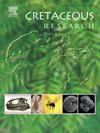Crocodyliform remains from the Upper Cretaceous (Turonian) Tamagawa Formation, northeastern Japan with preliminary dietary reconstruction through dental microwear texture analysis
IF 1.7
3区 地球科学
Q1 GEOLOGY
引用次数: 0
Abstract
Here we describe recently recovered crocodyliform remains from the Tamagawa Formation of Kuji Group, Kuji city, northeastern Japan. The material comprises osteoderms, vertebrae, a frontal bone, and isolated teeth. The dorsal paravertebral osteoderms bear a sagittal keel on the posterior half of the element, extending to its caudal margin, which indicates the presence of paralligatorids within the Kuji crocodyliform assemblage. Further, the Kuji crocodyliform assemblage may have consisted of multiple taxa, as the frontal bone lacks the sagittal keel characteristic of paralligatorids. Contemporaneous paralligatorids have been reported from Northeastern China, Mongolia, and Uzbekistan. The discovery of a potential paralligatorid from Kuji, Japan, suggests that paralligatorids were widely distributed across Asia, from coastal to inland regions, during the Late Cretaceous. Furthermore, potential diets of taxa included in the crocodyliform assemblage from Kuji were estimated through dental microwear texture analysis. The dental microwear texture observed in Kuji specimens is distinct from that of piscivorous and small crocodylians (skull length <20 cm), while comparable to that of large crocodylians consuming hard-objects (skull length >20 cm). Considering the existence of a medium-sized species (3 m total length) in the crocodyliform assemblage from Kuji, their diet probably included mid to large sized tetrapods, such as turtles and dinosaurs.

日本东北部上白垩世(Turonian) Tamagawa组鳄鱼形化石,通过牙齿微磨损结构分析初步重建饮食结构
在这里,我们描述了最近从日本东北部久治市久治组多摩川组中发现的鳄鱼形遗骸。该材料包括骨皮、椎骨、额骨和分离的牙齿。背侧椎旁骨皮的后半部有一个矢状龙骨,一直延伸到它的尾缘,这表明在Kuji鳄形组合中存在平行体。此外,由于额骨缺乏平行鳄的矢状龙骨特征,Kuji鳄鱼形组合可能由多个分类群组成。同时期在中国东北、蒙古和乌兹别克斯坦也有平行鳄的报道。在日本Kuji发现的一个潜在的平行体表明,在白垩纪晚期,平行体广泛分布在亚洲,从沿海到内陆地区。此外,通过牙齿微磨损纹理分析,估计了库集鳄鱼形组合中包括的类群的潜在饮食。在库集标本中观察到的牙齿微磨损纹理与鱼食性和小型鳄鱼(颅骨长度为20厘米)不同,而与食用硬物的大型鳄鱼(颅骨长度为20厘米)相当。考虑到Kuji鳄鱼形组合中存在一个中等大小的物种(总长度3米),它们的饮食可能包括中型到大型四足动物,如海龟和恐龙。
本文章由计算机程序翻译,如有差异,请以英文原文为准。
求助全文
约1分钟内获得全文
求助全文
来源期刊

Cretaceous Research
地学-地质学
CiteScore
4.10
自引率
19.00%
发文量
235
审稿时长
12 weeks
期刊介绍:
Cretaceous Research provides a forum for the rapid publication of research on all aspects of the Cretaceous Period, including its boundaries with the Jurassic and Palaeogene. Authoritative papers reporting detailed investigations of Cretaceous stratigraphy and palaeontology, studies of regional geology, and reviews of recently published books are complemented by short communications of significant new findings.
Papers submitted to Cretaceous Research should place the research in a broad context, with emphasis placed towards our better understanding of the Cretaceous, that are therefore of interest to the diverse, international readership of the journal. Full length papers that focus solely on a local theme or area will not be accepted for publication; authors of short communications are encouraged to discuss how their findings are of relevance to the Cretaceous on a broad scale.
Research Areas include:
• Regional geology
• Stratigraphy and palaeontology
• Palaeobiology
• Palaeobiogeography
• Palaeoceanography
• Palaeoclimatology
• Evolutionary Palaeoecology
• Geochronology
• Global events.
 求助内容:
求助内容: 应助结果提醒方式:
应助结果提醒方式:


